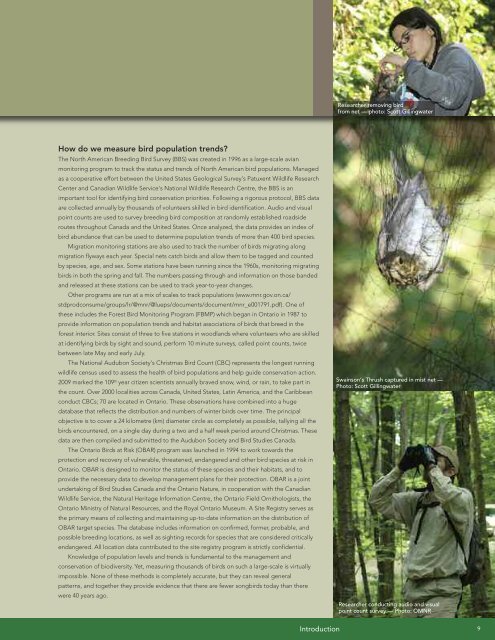A land manager's guide to conserving habitat for forest birds in ...
A land manager's guide to conserving habitat for forest birds in ...
A land manager's guide to conserving habitat for forest birds in ...
You also want an ePaper? Increase the reach of your titles
YUMPU automatically turns print PDFs into web optimized ePapers that Google loves.
Researcher remov<strong>in</strong>g bird<br />
from net — pho<strong>to</strong>: Scott Gill<strong>in</strong>gwater<br />
How do we measure bird population trends?<br />
The North American Breed<strong>in</strong>g Bird Survey (BBS) was created <strong>in</strong> 1996 as a large-scale avian<br />
moni<strong>to</strong>r<strong>in</strong>g program <strong>to</strong> track the status and trends of North American bird populations. Managed<br />
as a cooperative ef<strong>for</strong>t between the United States Geological Survey’s Patuxent Wildlife Research<br />
Center and Canadian Wildlife Service’s National Wildlife Research Centre, the BBS is an<br />
important <strong>to</strong>ol <strong>for</strong> identify<strong>in</strong>g bird conservation priorities. Follow<strong>in</strong>g a rigorous pro<strong>to</strong>col, BBS data<br />
are collected annually by thousands of volunteers skilled <strong>in</strong> bird identification. Audio and visual<br />
po<strong>in</strong>t counts are used <strong>to</strong> survey breed<strong>in</strong>g bird composition at randomly established roadside<br />
routes throughout Canada and the United States. Once analyzed, the data provides an <strong>in</strong>dex of<br />
bird abundance that can be used <strong>to</strong> determ<strong>in</strong>e population trends of more than 400 bird species.<br />
Migration moni<strong>to</strong>r<strong>in</strong>g stations are also used <strong>to</strong> track the number of <strong>birds</strong> migrat<strong>in</strong>g along<br />
migration flyways each year. Special nets catch <strong>birds</strong> and allow them <strong>to</strong> be tagged and counted<br />
by species, age, and sex. Some stations have been runn<strong>in</strong>g s<strong>in</strong>ce the 1960s, moni<strong>to</strong>r<strong>in</strong>g migrat<strong>in</strong>g<br />
<strong>birds</strong> <strong>in</strong> both the spr<strong>in</strong>g and fall. The numbers pass<strong>in</strong>g through and <strong>in</strong><strong>for</strong>mation on those banded<br />
and released at these stations can be used <strong>to</strong> track year-<strong>to</strong>-year changes.<br />
Other programs are run at a mix of scales <strong>to</strong> track populations (www.mnr.gov.on.ca/<br />
stdprodconsume/groups/lr/@mnr/@lueps/documents/document/mnr_e001791.pdf). One of<br />
these <strong>in</strong>cludes the Forest Bird Moni<strong>to</strong>r<strong>in</strong>g Program (FBMP) which began <strong>in</strong> Ontario <strong>in</strong> 1987 <strong>to</strong><br />
provide <strong>in</strong><strong>for</strong>mation on population trends and <strong>habitat</strong> associations of <strong>birds</strong> that breed <strong>in</strong> the<br />
<strong>for</strong>est <strong>in</strong>terior. Sites consist of three <strong>to</strong> five stations <strong>in</strong> wood<strong>land</strong>s where volunteers who are skilled<br />
at identify<strong>in</strong>g <strong>birds</strong> by sight and sound, per<strong>for</strong>m 10 m<strong>in</strong>ute surveys, called po<strong>in</strong>t counts, twice<br />
between late May and early July.<br />
The National Audubon Society’s Christmas Bird Count (CBC) represents the longest runn<strong>in</strong>g<br />
wildlife census used <strong>to</strong> assess the health of bird populations and help <strong>guide</strong> conservation action.<br />
2009 marked the 109 th year citizen scientists annually braved snow, w<strong>in</strong>d, or ra<strong>in</strong>, <strong>to</strong> take part <strong>in</strong><br />
the count. Over 2000 localities across Canada, United States, Lat<strong>in</strong> America, and the Caribbean<br />
conduct CBCs; 70 are located <strong>in</strong> Ontario. These observations have comb<strong>in</strong>ed <strong>in</strong><strong>to</strong> a huge<br />
database that reflects the distribution and numbers of w<strong>in</strong>ter <strong>birds</strong> over time. The pr<strong>in</strong>cipal<br />
objective is <strong>to</strong> cover a 24 kilometre (km) diameter circle as completely as possible, tally<strong>in</strong>g all the<br />
<strong>birds</strong> encountered, on a s<strong>in</strong>gle day dur<strong>in</strong>g a two and a half week period around Christmas. These<br />
data are then compiled and submitted <strong>to</strong> the Audubon Society and Bird Studies Canada.<br />
The Ontario Birds at Risk (OBAR) program was launched <strong>in</strong> 1994 <strong>to</strong> work <strong>to</strong>wards the<br />
protection and recovery of vulnerable, threatened, endangered and other bird species at risk <strong>in</strong><br />
Ontario. OBAR is designed <strong>to</strong> moni<strong>to</strong>r the status of these species and their <strong>habitat</strong>s, and <strong>to</strong><br />
provide the necessary data <strong>to</strong> develop management plans <strong>for</strong> their protection. OBAR is a jo<strong>in</strong>t<br />
undertak<strong>in</strong>g of Bird Studies Canada and the Ontario Nature, <strong>in</strong> cooperation with the Canadian<br />
Wildlife Service, the Natural Heritage In<strong>for</strong>mation Centre, the Ontario Field Ornithologists, the<br />
Ontario M<strong>in</strong>istry of Natural Resources, and the Royal Ontario Museum. A Site Registry serves as<br />
the primary means of collect<strong>in</strong>g and ma<strong>in</strong>ta<strong>in</strong><strong>in</strong>g up-<strong>to</strong>-date <strong>in</strong><strong>for</strong>mation on the distribution of<br />
OBAR target species. The database <strong>in</strong>cludes <strong>in</strong><strong>for</strong>mation on confirmed, <strong>for</strong>mer, probable, and<br />
possible breed<strong>in</strong>g locations, as well as sight<strong>in</strong>g records <strong>for</strong> species that are considered critically<br />
endangered. All location data contributed <strong>to</strong> the site registry program is strictly confidential.<br />
Knowledge of population levels and trends is fundamental <strong>to</strong> the management and<br />
conservation of biodiversity. Yet, measur<strong>in</strong>g thousands of <strong>birds</strong> on such a large-scale is virtually<br />
impossible. None of these methods is completely accurate, but they can reveal general<br />
patterns, and <strong>to</strong>gether they provide evidence that there are fewer song<strong>birds</strong> <strong>to</strong>day than there<br />
were 40 years ago.<br />
Swa<strong>in</strong>son’s Thrush captured <strong>in</strong> mist net —<br />
Pho<strong>to</strong>: Scott Gill<strong>in</strong>gwater<br />
Researcher conduct<strong>in</strong>g audio and visual<br />
po<strong>in</strong>t count survey — Pho<strong>to</strong>: OMNR<br />
Introduction 9

















